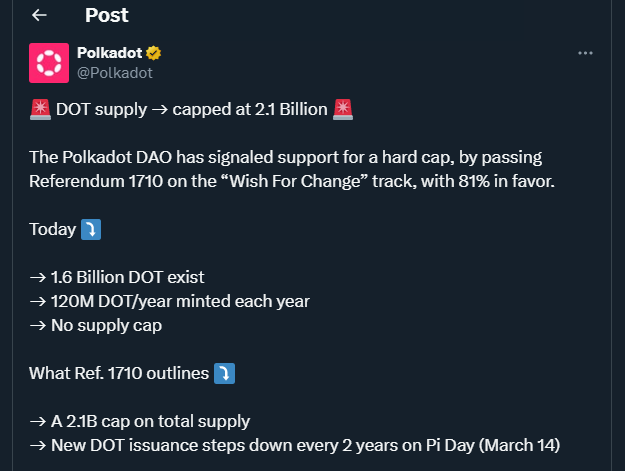TL;DR
- Polkadot’s DAO approved a referendum establishing a hard cap of 2.1 billion DOT tokens, replacing its previous open-ended inflationary model.
- The supply, currently around 1.5 billion, could have exceeded 3.4 billion by 2040 without this change.
- Alongside the shift in tokenomics, Polkadot launched a new capital markets division to connect institutional investors with blockchain-based opportunities.
Polkadot has introduced a significant update to its economic framework by implementing a hard cap on the supply of its native DOT token. For the first time since its launch, the network will no longer follow an unlimited inflationary model, instead capping its supply at 2.1 billion tokens. This marks a structural adjustment designed to reinforce long-term sustainability and investor confidence.
Previously, Polkadot minted approximately 120 million tokens per year without a ceiling on total supply. Under those conditions, projections indicated more than 3.4 billion DOT could have circulated by 2040. The newly approved model introduces a gradual issuance reduction that takes place every two years, scheduled symbolically on March 14, also known as Pi Day. With a current supply of 1.5 billion DOT, the new system is expected to slow growth while introducing long-term scarcity.
Institutional Expansion Gains Momentum
The timing of this tokenomics shift aligns with Polkadot’s strategy to attract institutional players. In August, the project announced the formation of the Polkadot Capital Group, a division aimed at bridging Wall Street with blockchain innovation. The initiative will provide institutional investors access to Polkadot’s infrastructure across fields such as asset management, banking, venture capital, and over-the-counter trading.
By positioning itself in the capital markets space, Polkadot is highlighting use cases that include decentralized finance, staking, and real-world asset tokenization. This dual strategy of refining tokenomics while engaging institutions demonstrates the network’s intent to secure relevance within both retail and professional investment circles.

Market Reaction And Long-Term Outlook
Despite the structural improvements, DOT’s price did not respond positively in the short term. Following the announcement, the token slid nearly 5%, falling from $4.35 to $4.15. Still, many analysts believe the long-term effect will be favorable, as capping supply reduces inflationary pressure and establishes greater predictability for investors.
For a project long known for its technical innovation, the decision to enforce monetary discipline represents a decisive evolution in its economic vision. By combining predictable tokenomics with institutional outreach, Polkadot is positioning itself for a more mature role in the digital asset ecosystem.











